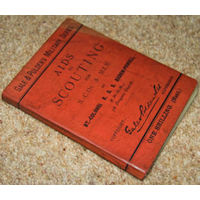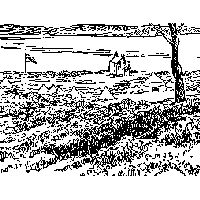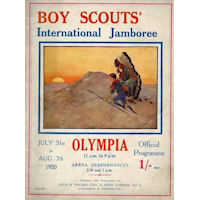

18TH ST ALBANS
AQUILA
SCOUT TROOP
Other information > History section > Scouting timeline
SCOUTING TIMELINE

There have been many books on the history of Scouting and now there are several web site on Scouting history. These dates are merely a guide to the timeline from to the present: sometimes it is difficult to ascribe an exact year to a key development.
1899: Baden-Powell’s book “Aids to Scouting” is published, while “BP” is still in South Africa during the Boer War. The book is to instruct the young army scouts, but it is a hit with young people in Britain who use it as a manual of how to learn about the outdoors, how to look after themselves and organise camping trips etc to get out of the cities. This is sometimes described as “the book that started it all”.

1907: Leading from the unexpected success of “Aids to Scouting” with the young people of Britain, BP – now a war hero – organises an experimental camp for boys on Brownsea Island in Poole Harbour on England’s south coast. This is often considered the start of Scouting, but actually predates any Scouting organisation. At the time the experiment was more to do with developing new methods of training boys. However, the elements were there: a Patrol system and camping!

1908: BP publishes “Scouting for Boys”. Initially it is to be a series of regular periodical booklets. After a few issues, its success is clear and BP starts the Scout Association, the forerunner of modern Scouting organisations around the world. “Scouting for Boys” is completed with the 6th part and then published as the manual for the Scout Association.
The periodical becomes a mini broadsheet magazine for Scouts, called “The Scout” and continued to be published until the 1960s. The first Summer Camp of the new organisation is held in Northumbria in northern England, and a competition for a free place at this camp is in the first issue of “The Scout”.

1910: Scouting spreads rapidly round the world and 1910 is but one key date in this international expansion, when the first Scout Handbook for scouting in the USA is published. This at first is an adaptation of “Scouting for Boys” by Seton, and later became termed “the original edition”, predating “the first edition” by a year.

1912: Meanwhile in Britain, Scout Troops have started up all over the countries. Girls and younger brothers are getting involved. To accommodate girls, a new organisation is started: Guiding.
1916: A separate section for younger boys is started, Wolf Cubs, the forerunner of modern Cub Scouts. Rudyard Kipling’s Jungle Book provided the theme for this new section, and so today some Packs still call their leaders after Jungle Book characters, especially Akela for the Cub Leader.

1920: The first World Jamboree is held in London. This was a camp gathering of Scouts from many parts of the world. At this event, they camped in parks across London and outside, and the actual Jamboree events were focussed on Olympia stadium. In fact, the Olympia Jamboree was not really considered the “First World Jamboree” at the time: there had been other previous international gatherings, some of which may have had similar size.
World Jamborees thereafter were held every few years all over the world with many thousands of Scouts camping together at one site.

1929: World Jamborees returns to England on special dates in Scouting. The Coming of Age World Jamboree is in Arrowe Park, near Liverpool. This celebrates 21 years of Scouting. At that time 21 was the age of adulthood, such as getting the vote: the 18th birthday had much less significance.
1950-ish: Senior Scouts becomes a separate section: these are the forerunners of Venture Scouts, then Explorers

1957: The Jubilee World Jamboree is held in Sutton Park near Birmingham. This celebrates 50 years of Scouting. The badge also indicates that it was the centenary of BP’s birth.
1986: A new section for younger boys starts in mainland Britain, Beavers
1990: Girls can become Beavers, Cubs, and Scouts
2007: The centenary World Jamboree is in England at Hylands Park Park, Essex with events at Brownsea Island